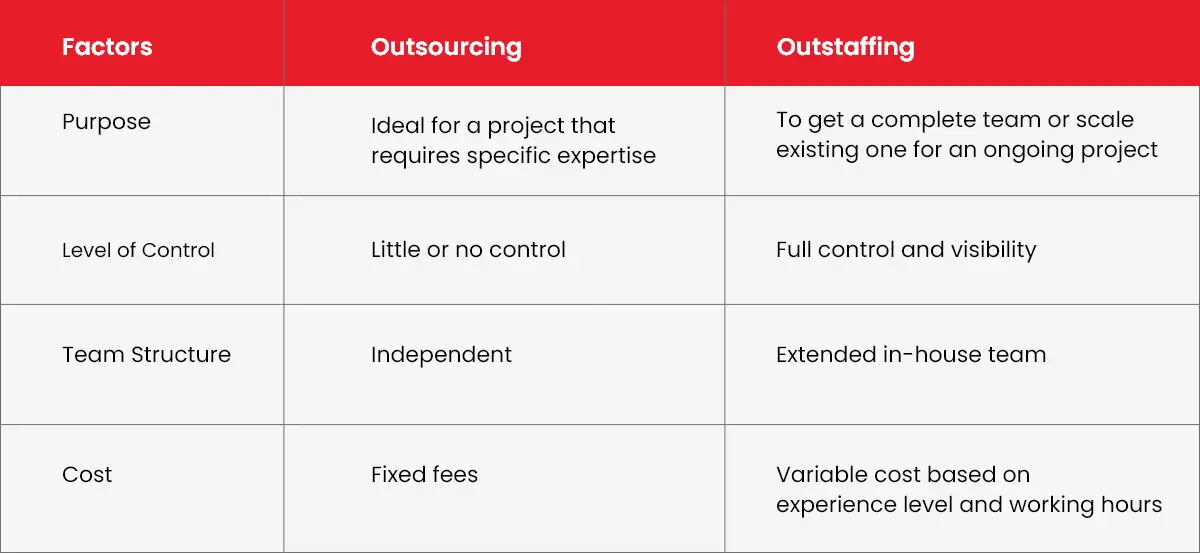Should I outsource or outstaff for my business? Well, both save you money on hiring full-time employees for your project, they are not the same. Surprised? In our blog, we are discussing key differences between each to clear your confusion on outsourcing vs outstaffing.
What is Outsourcing?
Imagine you need a stunning new website for your business. But you don’t have experts for this project. Instead of hiring web developers, you look for a web design agency to handle the entire project. This is called outsourcing in the IT industry. That agency will take care of everything, from developing, and designing to launching the website.
Development outsourcing is a popular choice for many businesses, but it’s essential to understand how software outsourcing and outstaffing differ in terms of control, flexibility, and team integration.
There are three types of outsourcing depending upon the location of third-party service providers.
- Onshore: The hired agency or company is located in the same country.
- Nearshore: Third-party service provider is either in the neighboring country or works in the same time zone.
- Offshore: The service provider is located in a different country.
Many businesses opt for offshore outsourcing as the developers are less costly in other regions. For example, the cost of mobile app development services in the US is approx. $95 to $100 whereas it’s $70 to $90 in Australia.
Benefits and Risks of Outsourcing
Outsourcing is perfect if you have a small team with limited expertise, short-term project requirements, or looking for ways to reduce costs. If partnered with the right agency, you can gain direct benefits from outsourcing software development.
- Quality work at less cost.
- More productivity as the internal team gets more time for core tasks.
- Access to diverse talent.
- Flexible resources with the option to pay for services only you are using.
- Rapid product development and deployment.
- No management headaches.
While these pros of outsourcing and outstaffing make it an ideal model for many businesses, it comes with some cons as well:
- Limited control over the project as the third-party service provider is completely responsible for the project.
- There may be communication barriers especially if outsourcing agency works at different time zones. It means your project will progress more slowly than expected.
- Since you need to share confidential information about your business or customers with a third-party vendor, there’s a security risk too.
These are direct cons of outsourcing, but it also impacts indirectly to your business. It can lead to fear of job loss among your employees hindering their productivity. Team management issues can also occur as the outsourced employees may not be loyal or dedicated.
Should I opt for an Outstaffing Model?
Yes! If you need skilled professionals say certified Kentico developers to work on your specific projects, outstaffing is the best. They are like an extension of your in-house team of developers but work from different locations.
You can manage, assign tasks, and give them project direction directly without the involvement of a third-party vendor. However, the vendor will be the official employer and handle their salaries, taxes, and other employment-related tasks.
Benefits of Outstaffing
- Save money on expenses like office space, and resources.
- Get specialists and experts missing from your internal team.
- Expand or shrink resources based on the requirements and the budget.
- Less burden of administrative and financial issues.
- Easily track the progress of your project.
Risks of Outstaffing
- Language and cultural barriers may add challenges.
- Management of remote employees is up to you.
What is the Difference Between Outsourcing and Outstaffing?
Though both outsourcing and outstaffing models are profitable for your business, one is better than the other based on particular needs. Here are some key differences that can change your choice.

These key differences help you choose between the two. Thus, let’s understand them in detail:
1. Purpose
Outstaffing is best if you already have an IT team and need to expand it quickly without spending on recruitment or remote setup. Outsource if you don’t have an IT team but need experts for project development.
2. Control
Outstaff if you want the complete control of remote staff in your hands. In case you don’t care about the project’s code and focus only on getting things done, leave everything to experts by outsourcing.
3. Team Structure
Outsource if you are okay with less communication between remote employees and your internal team. Communication and collaboration are important in the outstaffing model.
4. Cost
Both are budget-friendly only if you know what you need and what you can afford.
Tips to Get the Right Resources
Finding the right partner for outsourcing IT services or outstaffing needs is itself a big task. However, you can make the right decision by asking the right questions.
Questions to Ask from Yourself
- What are your specific needs and goals for this project/task?
- What is your budget for outsourcing/outstaffing?
- What is your preferred timeline for completion?
Questions to Ask from Third-Party Vendor/Provider
- How long have you been in the staff augmentation business?
- Do you have experts in my industry niche?
- How will you handle the communication?
- What is your process for project management and reporting?
- Who will be my dedicated point of contact on your team?
- How will we handle any disputes or disagreements that may arise?
- How do you handle billings?
Specific Questions if You Are Outstaffing
- What is your recruitment process for finding qualified workers?
- What are the qualifications and experience levels of the staff you propose to outstaff?
- How will remote employees integrate into my existing team?
- What is the process for onboarding and training the outstaffed workers?
Specific Questions if You Are Outsourcing
- What type of IT services do you outsource?
- What level of control will I have over the work process?
- Who will be responsible for intellectual property rights?
- What is your termination clause in case the partnership doesn’t work out?
Additional Tips to Keep in Mind
- Don’t stick to one, instead, get quotes from multiple vendors and negotiate pricing and terms to get the best possible deal.
- Clearly define your expectations, project scope, and service level agreement (SLA) to avoid misunderstandings later.
Conclusion
Adding new resources to your team is a big decision for your business and thus requires careful planning and selection. Outsourcing and outstaffing being the most popular hiring models require a better understanding of each. The above key differences, pros, and cons of outsourcing vs outstaffing, and questions to consider will help you reach a better decision. However, the final decision lies in the type of requirements and budget you have.







